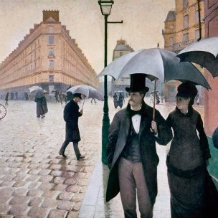Period Band C
Art in Paris in the 19th Century
Tutor: Sylvie Simonds
Description
The intention of the course is to provide an overview of the main developments in French art in the thirty years after 1850, and of the principal interpretations offered by art historians. The teaching will begin by looking at the academic and so-called 'independent' art of the period and by referring to the themes and preoccupations of French art inherited by artists in 1850. We will then move on to Realism, Impressionism and finally to Post-Impressionism, looking at these developments through the recent literature in the field. We will concentrate particularly on the idea of modernity and on 'the painting of modern life.' After the introductory section, the bulk of the course will be thematic in organisation, and will deal with topics which will include the nude, the city, pleasure, and the idea of contemporaneity.
Objectives
By the end of the module, students should have acquired:
- familiarity with the works of art
- knowledge of the major issues raised by the recent literature in the field
- an ability to analyse works of art in relation to social developments in the period
Preliminary Reading
The bibliography on c19 French art is vast - but don't despair! In preparation for the module you should familiarise yourself with the art works reproduced in any of the following (looking out for chronology, artists, styles). The following books will give you a sense of how we're going to approach the material, and getting to know some of these key texts over the holidays will help you to make the most out of the module.
Art in nineteenth-century Paris
- T.J. Clark, The Painting of Modern Life: Paris in the Art of Manet and his Followers (London: Thames and Hudson, 1985) - this is effectively the course book, a classic of the social history of art
- Robert L. Herbert, Impressionism (Yale) – a scholarly study of the social historical aspects of Impressionism from a very different perspective to Clark’s.
- Stephen F. Eisenmann, Nineteenth Century Art: A Critical History, 2nd ed (Thames & Hudson) - much useful information about the art and its contexts.
- Paul Smith, Impressionism (Everyman Art Library) – a good introduction
- John Rewald, The History of Impressionism (MOMA)
Historical context
We'll be reading much more detailed historical investigations of more specific topics, but I'd like you to get to grips with the major social and political events in France from 1789 onwards (look that date up if you don't know it!) The following are two manageable introductions:
- M. Crook, Revolutionary France 1788-1880 (Oxford: Oxford University Press, 2002)
- P. McPhee, A Social History of France 1789-1914 (Houndsmill: Palgrave Macmillan, 2004) (this is also available as an e-book on the library website)
For a broader European survey, see Eric Hobsbawm's three volumes, The Age of Revolution, The Age of Capital, The Age of Empire
On the cultural and literary context of c19 Paris, see Christopher Prendergast, Paris and the Nineteenth Century (Oxford and Cambridge, MA.: Blackwell, 1995)
Nineteenth-century French novels
To give you a sense of the broader social and cultural context of c19 Paris, you might want to read some novels of the period, many of which are concerned with social conditions or feature artists. Some suggestions include:
- Balzac, Illusions perdues (Lost Illusions) ; Le Chef-d'oeuvre inconnu (The Unknown Masterpiece)
- Flaubert, Madame Bovary
- The Goncourts, Germinie Lacerteux
- JK Huysmans, À rebours (Against the Grain or Against Nature)
- Maupassant, Short Stories
- Zola, L'Oeuvre (The Masterpiece); L'Assommoir (usually has this title in English)

